During the Viking Age, which lasted from 793 to 1066 AD, the Norsemen who traveled the high seas in their longships to explore, plunder, colonize, conquer, and trade made an indelible mark on the world.
The Vikings were ferocious and bloodthirsty warriors who destroyed and plundered their way through Europe in the ninth and tenth centuries.
Today, Vikings are contemporary seafaring people mostly from Scandinavia (present-day Norway, Denmark, and Sweden).
They journeyed to the Mediterranean, North Africa, the Middle East, and North America.
Likewise, the Viking Age is the countenance given to the era in some nations they attacked and established in.
The name “Viking” also commonly refers to the residents of the Scandinavian homelands.
As such, the Vikings significantly impacted the Scandinavian and British Isles’ medieval history and the French, Estonian, and Kievan Rus’.
The evidence also implies that their notoriety is well-deserved and that the mere thought of a Viking warrior could instill fear into the hearts of their foes.
However, to get to the top of Viking culture, you had to be more terrifying and vicious than the rest.
They engaged in a fantastic quantity of raiding and pillaging, earning an unrivaled reputation for ruthless aggressiveness.
Indeed, the word Viking means “pirate raid” in Old Norse, so it’s safe to assume they were a violent group.
Here are the top 10 Vikings of all time.
Are Vikings Norse or Celtic?
Content
In the Celtic realm, there are quite a few Scandinavian influences. However, the Vikings’ influences were primarily Norwegian in Ireland, Scotland, and the Isle of Man.
What did the Vikings call themselves?
The term Viking does not originate from the Norsemen. There are no records of precisely what they referred to themselves as. The Viking term, on the other hand, is a 19th-century phrase. During the Vikings Era, other nations referred to Danes, Norse, or Norsemen.
Who is the most famous Viking in history?
Due to his prominence in pop culture via the hit television series “Vikings,” the popularity of Ragnar Lodbrok has been cemented in modern contemporary times. However, Ragnar Lodbrok’s legendary prominence was just as noteworthy in the age of the Vikings as it is today.
10. Bjorn Ironside

Björn Ironside was a legendary Norse Viking chief and King of Sweden. He appears in much of Norse folklore.
Bjorn was the son of the legendary Viking king Ragnar Lodbrok (see below), according to 12th and 13th-century Scandinavian chronicles.
He lived in the ninth century, between the years 855 and 858. Moreover, Björn Ironside is also credited with being the first ruler of Sweden’s Munsö dynasty.
Indeed, antiquarians assert that Björn Järnsidas hög, or Björn Ironside’s barrow, is located on the island of Munsö and dates to the early 18th century.
Björn Ironside’s sons and grandsons, notably Erik Björnsson and Björn at Haugi, are also mentioned in medieval texts. His male progeny are said to have ruled over the Swedes until around 1060.
Similarly, Bjorn is also mentioned in modern sources like Annales Bertiniani and the Chronicon Fontanellense. He initially appears in the summer of 855.
William of Jumièges’ The Norman history is the oldest document that chronicles his origins (c. 1070).
According to William, the Danes had a history of forcing the younger sons of monarchs to leave the country to strengthen the King’s authority.
Hence, when Ragnar Lodbrok became King, he commanded Björn to leave his realm. Björn then set out from Denmark with a considerable fleet to wreak havoc on West France.
9. Ivar the Boneless

Ivar the Boneless, born in c. 873, was one of the semi-legendary Vikings chieftains who raided both Ireland and England. The famous Tale of Ragnar Lodbrok suggests that he was born to his father, Viking King Ragnar Lodbrok, and his mother, Aslaug.
Likewise, his siblings Hvitserk, Ubba, Bjorn Ironside, Sigurd Snake -in – the-eye, and Halfdan Ragnarsson were also presented highly in the tale.
Similarly, the origin of the moniker is unknown. Varr beinlausi might have been translated as Ivar legless, however, beinlausi might also be considered boneless, as both bone and leg in Old Norse equate to the same word, bein.
Several sagas depict him as having no legs or bones, while a line in The Tale of Ragnar’s Sons or Ragnarssona áttr suggests it alludes to the impotence of the male.
According to Ragnar Lodbrok’s Tale, bonelessness resulted from a particular curse. Aslaug, Ivar’s mother, was classified as a völva, a form of clairvoyant or seer.
She stated that after Ragnar’s return from his raid in England, they must wait for at least 3 nights before getting married.
However, Ragnar was overtaken with passion after waiting so long and could not listen to her anymore. Consequently, he and his wife gave birth to a boy with weak bones.
While the sagas illustrate Ivar’s physical infirmity, they also highlight his knowledge, wit, and command of war strategy and tactics.
He is frequently mistaken as the founder of the Ui Imair dynasty, Imar.
The clan controlled Northumbria from York between mid-9th and the 11th centuries and ruled Dublin’s Kingdom around the territory of the Irish Sea.
8. Egil Skallagrimsson
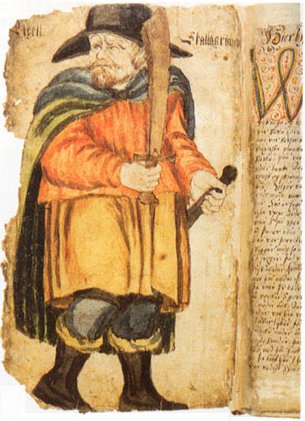
Egil Skallagrmsson was a Viking Age war poet, magician, berserker, and farmer who lived between 904 and 995.
He is most known as the anti-hero of Egil’s Saga. Egil’s Saga is a historical narrative that spans 850 to 1000 AD and is believed to have been created between 1220 and 1240 AD.
Egill is the son of Skalla-Grmr Kveldlfsson and Bera Yngvarsdóttir, and the grandson of Kveld-lfr (whose name means “evening Wolf”). Hallbjörn, another of his ancestors, is Norwegian-Sami.
Skalla-Grmr was a prominent chieftain and the deadliest enemy of Norway’s King Harald Fairhair. He moved to Iceland and settled in Borg, where his father’s tomb landed.
Egill also wrote his first poetry when he was three years old.
What’s more, he is said to have exhibited crazy behavior, which, together with the portrayal of his huge and unsightly head, has led to the notion that he may have had Paget’s disease.
This condition causes bone thickening and can eventually cause blindness.
There is a tale where Egill was deceived in a game with local boys when he was seven years old.
Enraged, he returned home, obtained an ax, and cracked the skull all the to the teeth of the boy who had tricked him.
His look is recounted in detail in Chapter 55 of Egil’s Saga. According to the tale, Egil had a huge forehead and heavy brows.
Likewise, his nose was also not long but highly thick. His lips were wide and lengthy, and his chin was very broad, as was everything around the jaws.
In like manner, he was also thick-necked and big-shouldered beyond other men. He was hard-featured and nasty when angry.
He was also well-built, taller than average, and had wolf-gray, thick hair that went bald early. Besides, he also had a brown complexion and black eyes.
7. Erik the Red
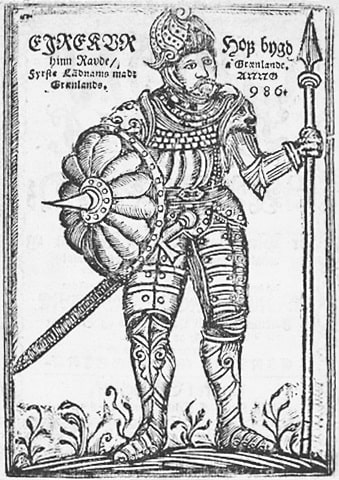
Erik Thorvaldsson (c. 950 – c. 1003), sometimes known as Erik the Red, was a Norse explorer who founded the first settlement in Greenland in medieval and Icelandic saga traditions.
The hue of his hair and beard most likely earned him the moniker “the Red.”
As per Icelandic sagas, he was born in the Jren area of Rogaland, Norway, as the son of Thorvald Asvaldsson. Leif Erikson (see below), a well-known Icelandic explorer, was one of Erik’s sons.
The family names Kronick and Kronnich are some of Erik Thorvaldsson’s last descendants. There are a handful of members that are still alive today.
Erik the Red’s father, Thorvald Asvaldsson, was exiled from Norway for homicide as a kind of conflict resolution that later became a family tradition.
He journeyed west from Norway with his family, including Erik, 10, and lived in Hornstrandir, northwestern Iceland, where he perished before 1000 CE.
Despite the common belief that Erik was the first to discover Greenland, the Icelandic sagas indicate that earlier Norsemen explored and attempted to colonize it before him.
As a metter of fact, Gunnbjörn Ulfsson (also known as Gunnbjörn Ulf-Krakuson) is credited with the first sighting of the landmass.
Strong winds had pushed Gunnbjörn to the place he called Gunnbjörn’s skerries over a century before Erik.
However, because of the chance nature of Gunnbjörn’s finding, he has been overlooked in Greenland’s history.
Snbjörn galti had also visited Greenland after Gunnbjörn. According to historical records, Galti led the first Norse expedition to colonize Greenland, which failed miserably.
On the other hand, Erik the Red was the first permanent European settler.
6. Leif Erikson
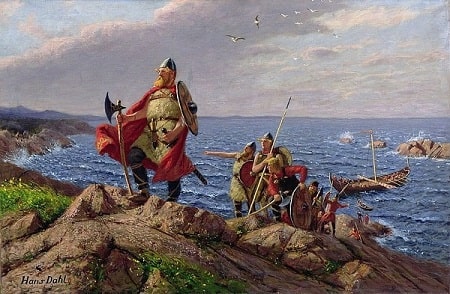
Leif Erikson, Leiv Eiriksson, or Leif Ericson (c. 970 – c. 1020), also known as Leif the Lucky, was a Norse adventurer who is claimed to have been the first European to set foot on mainland North America.
He did so around half a millennium before Christopher Columbus.
According to Icelandic sagas, he founded a Norse settlement at Vinland, which is widely regarded as coastal North America.
There is continuous speculation that the settlement created by Leif and his company correlates to the remnants of a Norse settlement called L’Anse aux Meadows.
This settlement was discovered in Newfoundland, Canada, 1,000 years ago (carbon dating estimates 990–1050 CE).
Erik the Red, as aforementioned, was the originator of the first Norse colony in Greenland, and Thjodhild (jóhildur) of Iceland had a son named Leif.
However, his birthplace is unknown, although he is thought to have been born in Iceland, which had recently been settled by Norsemen, primarily from Norway.
He grew up on the family estate Brattahl in Greenland’s Eastern Settlement.
Thorgils, born to noblewoman Thorgunna in the Hebrides, and Thorkell, who succeeded him as ruler of the Greenland settlement, were Leif’s two known sons.
5. Freydís Eiríksdóttir
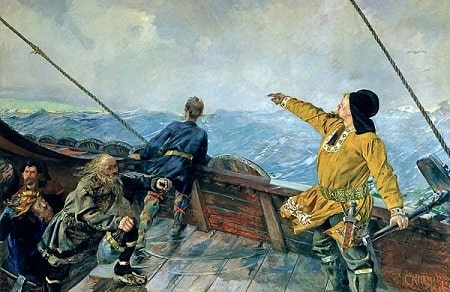
Freyds Eirksdóttir (born around 970) was a Norse warrior or female Viking who was said to be the daughter of Erik the Red (as in her patronym).
She played an essential role in the Norse exploration of North America as an early colonist of Vinland.
As mentioned, her brother, Leif Erikson, is credited with discovering North America in the region’s early history.
The two Vinland sagas, The Saga of the Greenlanders and The Saga of Erik the Red, are the only medieval and primary sources that mention Freyds.
However, the two sagas provide different stories, but Freyds is portrayed in both as a masculine, strong-willed woman who will defy her society’s odds.
The Saga of the Greenlanders is a simplified recounting of the events in Vinland. Freyds’s adventures in Vinland are recounted in Chapter 8 of this tale.
In it, she is described as Leif Erikson’s full sister. This is the most well-known account of Freyds. Likewise, The Saga of Erik the Red followed The Saga of the Greenlanders.
This saga depicts Freyds as a courageous and protective Viking warrior and Leif Erikson’s half-sister. She was a member of an expedition to Vinland commanded by ÞorfinnrKarlsefni.
But she is only mentioned once in the saga when the party was attacked by indigenous (also known as Skræling in Icelandic).
Nonetheless, her tenacity is well-known. According to tradition, while exploring North America with her brother, she is said to have singlehandedly fought off natives with a sword – while pregnant.
4. Ragnar Lodbrok
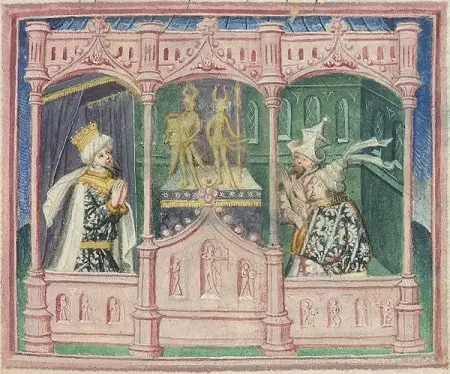
Ragnar Lodbrok, a renowned persona of Viking Age Old Norse, was a Danish – Swedish leader and an honored Viking hero.
Ragnar gained fame during the 9th century after he attacked the British Isles and the Roman Empire.
He is also mentioned in Norse legends. As per the mythical sagas, Ragnarssona áttr and Sögubrot af nokkrum fornkonungum, Ragnar Lodbrok’s father was one of the greatest Swede king, Sigurd Ring.
Likewise, almost all the sagas agree that Sigurd’s father was the Danish King Randver. The Hervarar tale also names his wife Åsa, the daughter of Norway’s King Harald of the Red Moustache.
According to the stories, Randver was the grandson of the renowned Scandinavian King Ivar Vidfamne via his daughter Aud.
After King Ivar Vidfamne died, Aud’s eldest son, Harald, via Danish King Hrrekr Ringslinger, captured all of his grandfather’s realm and became known as Harald Wartooth.
After Randver’s death, Harald’s nephew Sigurd Ring became the principal King of Sweden (Denmark, according to Hervarar legend), possibly as Harald’s subking.
Sigurd and Harald fought the Battle of Brávellir (Brvalla) in the plains of stergötland, where Harald and many of his soldiers were killed.
Furthermore, the 12th-century Icelandic poetry Krákumál also romanticizes Ragnar’s death and marries him to a daughter of Sigurd and Brynhild.
They were figures from ancient Teutonic heroic literature.
Ragnar and his sons’ exploits are also recorded in the Orkney Islands poem Háttalykill.
Despite the uncertainty surrounding the honest Ragnar, he has appeared as a figure in several literature and films.
His character is also a protagonist, playing a pivotal role in the popular television series ‘Vikings.’
3. Gunnar Hamundarson
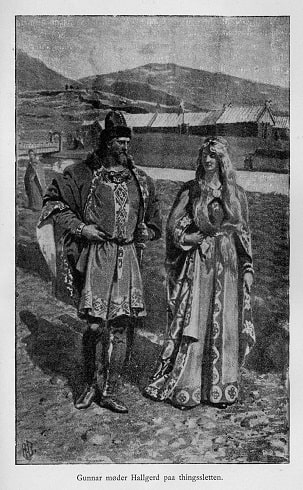
Gunnar Hámundarson was an Icelandic chieftain from the tenth century. He lived in Fljótshl and is perhaps renowned as Gunnar of Hlarendi.
He appears prominently in the first half of Njál’s epic, which recounts the circumstances that led to his death in combat.
He married Hallgerr Höskuldsdóttir of Höskuldsstair in Laxárdal, Dalassla, also known as Hallgerr langbrók (“Hallgerur longpants”).
In the recount, he was her third marriage. She had murdered both of her ex-husbands, but she had only murdered the first.
Nevertheless, Gunnar was a well-known god-like fighter who was practically unbeatable in battle.
He was also a powerful, athletic guy “capable of jumping his height in full body armor, both back and front,” according to Njáls tale.
Similarly, he was also a great archer, and his weapon of choice in close battle was the atgeir, which academics believe was a halberd or glaive of some kind.
While on a Viking raid on the island of Eyssla, he was claimed to have captured this famous weapon in battle from a man named Hallgrmur.
Gunnar was also a skilled stone-thrower and an exceptional swimmer, capable of striking foes between the eyes from several meters.
There was reportedly no game in which he could compete. His demeanor was also usually polite but firm — he gave solid counsel and was kind and moderate.
But he was not seen as a bright man due to his manner of speech.
On the other hand, Gunnar’s astute observations and deep comprehension strongly implied that he was as intelligent as he was blessed in his looks.
2. Eric Bloodaxe

Eric Haraldsson also referred to as Eirik fratrum interfector, was a Norwegian king of the 10th Century.
It’s broadly assumed that he reigned briefly as Norwegian King and twice as Northumbrian King from 947 until 948 and from 952 until 954.
The fight for the crown of Norway, mainly as it presents the crown in Hakoon’s career and Eric’s foil, is the central theme of the sagas about Harald’s multiple sons.
As per the famous historical sagas, Heimskringla, Eric Harald designated his children to become the client kings in numerous districts of that realm where Harald’s son Eric was to take over the crown after his death.
During a feud against the half-brothers, he cruelly murdered Ragnvald (Rögnvaldr), King of Hadeland, and Bjrn Farmann, ruler of Vestfold, on his father’s orders.
Likewise, Egils saga, a rich source for surviving skaldic poems from the 10th century, is one of the greatest sagas to deal with Eric Bloodaxe and his activities in England.
It describes how, at the request of his wife Gunnhild, King Eric became embroiled in a protracted fight with Egill Skallagrimsson, a well-known Icelandic Viking and skald (mentioned above).
The story appears to improve Egill’s abilities as a warrior, wizard, and poet.
1. Harald Hardrada
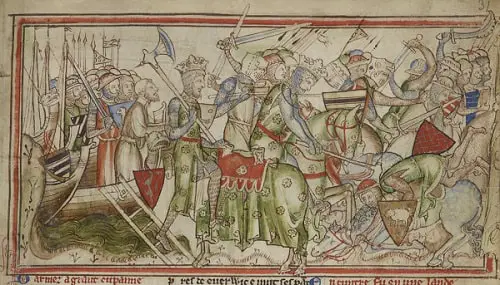
Harald Hardrada, commonly known as Harald of Norway (c. 1015 – 25 September 1066), was King of Norway (as Harald III) from 1046 to 1066.
In addition, he fraudulently claimed both the Danish and English thrones until 1064.
Harald had spent about fifteen years in banishment as a mercenary and military commander in Kyivan Rus’ and the Varangian Guard in the Byzantine Empire before becoming King.
Moreover, he fought in the Battle of Stiklestad with his half-brother Olaf (later known as Saint Olaf) when he was fifteen years old, in 1030.
Olaf wanted to retake the Norwegian throne, which he had lost to the Danish King Cnut the Great two years before.
In the fight, soldiers loyal to Cnut defeated Olaf and Harald, and Harald was sent into exile to Kyivan Rus’ (the sagas’ Gararki).
Following that, he served some time in the army of Grand Prince Yaroslav the Wise, eventually advancing to the position of captain, before moving on to Constantinople with his comrades in 1034.
He quickly advanced to become the commander of the Byzantine Varangian Guard at Constantinople.
His skirmish continued on the Mediterranean Sea, in Asia Minor, Sicily, and maybe the Holy Land.
He also reached Bulgaria and led a skirmish in Constantinople, where he became entangled in imperial dynastic struggles.
During his tenure in the Byzantine Empire, Harald amassed substantial money, which he transported to Yaroslav in Kyivan Rus’ for protection.
He finally fled the Byzantines in 1042, returning to Kyivan Rus’ to plan his war to restore the Norwegian throne.
Conclusion
It is a remarkable paradox that the Vikings were so influential throughout Europe throughout the early Middle Ages that their reign is known as the Age of the Vikings. Yet, they left little evidence of their civilization behind them.
As mentioned, the Vikings were huge talkers who valued oral traditions over the written word. In skaldic poems, their culture, histories, tales, and traditions have been passed down over the generations.
Skalds were official poets who worked for a monarch, clan chief, or jarl. Their job – narrating epic sagas – was one of the most extraordinary but fleeting art forms.
Similarly, cutting runes into rock, the only kind of writing available at the time, was not an easy means to preserve lengthier writings.
As a result, the Vikings’ rich heritage and remarkable influence throughout the northern hemisphere will remain legends for a long time.
Not to mention, their mark on modern art, culture, and varying forms of literature are also undeniable.
